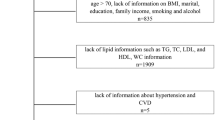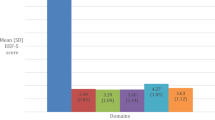Abstract
Up to 40% of cases of erectile dysfunction (ED) originate from vascular disturbances associated with atherosclerotic disease, leading to the previously proven concomitance between ischaemic heart disease (IHD) and ED. The aim of this study was to evaluate patients’ knowledge about modifiable risk factors for ED. The evaluated group of patients was composed of 502 male patients undergoing cardiac rehabilitation and receiving treatment for IHD. The patients’ knowledge of risk factors for ED linked to IHD was assessed with an original survey. The presence of ED was assessed using an abridged version of the International Index of Erectile Function-5 questionnaire. Increase in leisure-time physical activity was estimated using a leaflet based on the Framingham questionnaire. In all, 189 participants were unable to name any modifiable ED risk factors, and only 31 patients knew all 6 of them. The most frequently mentioned ED risk factor was smoking, whereas the least frequently mentioned was sedentary lifestyle. Awareness of smoking as an ED risk factor was closely related to the patients’ level of education, place of residence, smoking and underlying ED in the individual patient. The ability to classify diabetes as a risk factor for ED was significantly related to the patients’ level of education, place of residence, and the prevalence of diabetes in the evaluated group of respondents. The same relations were observed regarding hyperlipidaemia. Awareness of the negative impact a sedentary lifestyle has on the erectile process was found to be closely related to the patients’ age, as well as their level of education. The performed study demonstrates the poor knowledge of IHD patients about the modifiable risk factors for ED. The factor that patients are the least aware of is sedentary lifestyle, which, simultaneously, is the risk factor that most frequently affects the respondents.
This is a preview of subscription content, access via your institution
Access options
Subscribe to this journal
Receive 8 print issues and online access
$259.00 per year
only $32.38 per issue
Buy this article
- Purchase on Springer Link
- Instant access to full article PDF
Prices may be subject to local taxes which are calculated during checkout


Similar content being viewed by others
References
Ayta IA, McKinlay JB, Krane RJ . The likely worldwide increase in erectile dysfunction between 1995 and 2025 and some possible policy consequences. BJU Int 1999; 84: 50–56.
Montorsi F, Salonia A, Montorsi P . May erectile dysfunction predict ischemic heart disease? J Urol 2002; 167: 148–149.
Greenstein A, Chen J, Miller H, Matzkin H, Villa Y, Braf Z . Does severity of ischaemic coronary disease correlate with erectile function? Int J Impot Res 1997; 9: 123–126.
Kirby M, Jackson G, Betteridge J, Friedli K . Is erectile dysfunction a marker for cardiovascular disease? Int J Clin Pract 2001; 55: 614–618.
Jackson G, Boon N, Eardley I, Kirby M, Dean J, Hackett G et al. Erectile dysfunction and coronary artery disease prediction: evidence-based guidance and consensus. Int J Clin Pract 2010; 64: 848–857.
Gupta BP, Murad MH, Clifton MM, Prokop L, Nehra A, Kopecky SL . The effect of lifestyle modification and cardiovascular risk factor reduction on erectile dysfunction: a systematic review and meta-analysis. Arch Intern Med 2011; 171: 1797–1803.
Perk J, De Backer G, Gohlke H, Graham I, Reiner Z, Verschuren M et al. European Guidelines on cardiovascular disease prevention in clinical practice (version 2012). The Fifth Joint Task Force of the European Society of Cardiology and Other Societies on Cardiovascular Disease Prevention in Clinical Practice (constituted by representatives of nine societies and by invited experts). Eur Heart J 2012; 33: 1635–1701.
Drygas W, Jegier A, Kostka H, Kuński H . Long-term effects of different physical activity levels on coronary risk factors in midle-aged men. Int J Sports Med 2000; 21: 235–241.
Arsenault BJ, Rana JS, Lemieux I, Després JP, Wareham NJ, Kastelein JJ et al. Physical activity, the Framingham risk score and risk of coronary heart disease in men and women of the EPIC-Norfolk study. Atherosclerosis 2010; 209: 261–265.
Kannel WB . Contribution of the Framingham study to preventive cardiology. J Am Coll Cardiol 1990; 15: 206–211.
Rosen RC, Cappelleri JC, Smith MD, Lipsky J, Peña BM . Development and evaluation of an abridged, 5-item version of the International Index of Erectile Function (IIEF-5) as a diagnostic tool for erectile dysfunction. Int J Impot Res 1999; 11: 319–326.
Mahmood SS, Levy D, Vasan RS, Wanq TJ . The Framingham Heart Study and the epidemiology of cardiovascular disease: a historical perspective. Lancet 2014; 383: 999–1008.
Gandaglia G, Briganti A, Jackson G, Kloner RA, Montorsi F, Montorsi P et al. Systematic Review of the association between erectile dysfunction and cardiovascular disease. Eur Urol 2014; 65: 968–978.
Glina S, Sharlip ID, Hellstrom WJG . Modifying risk factors to prevent and treat erectile dysfunction. J Sex Med 2013; 10: 115–119.
Baumgartner MK, Hermanns T, Cohen A, Schmid DM, Seifert B, Sulser T et al. Patients' knowledge about risk factors for erectile dysfunction is poor. J Sex Med 2008; 10: 2399–2404.
Green JSA, Holden STR, Ingram P, Bose P, George DP, Bowsher WG . An investigation of erectile dysfunction in Gwent, Wales. BJU Int 2001; 88: 551–553.
O’Donnell AB, Araujo AB, McKinlay JB . The health of normally aging men: The Massachusetts Male Aging Study (1987–2004). Exp Gerontol 2004; 39: 975–984.
Feldman HA, Goldstein I, Hatzichristou DG, Krane RJ, McKinlay JB . Impotence and its medical and psychosocial correlates: results of the Massachusetts male aging study. J Urol 1994; 151: 54–61.
Kaminetsky J . Epidemiology and pathophysiology of male sexual dysfunction. Int J Impot Res 2008; 20: 3–10.
Jackson G, Rosen RC, Kloner RA, Kostis JB . The second Princeton consensus on sexual dysfunction and cardiac risk: new guidelines for sexual medicine. J Sex Med 2006; 3: 28–36.
Jackson G . Erectile dysfunction and coronary disease: evaluating the link. Maturitas 2012; 72: 263–264.
Lyngdorf P, Hemmingsen L . Epidemiology of erectile dysfunction and its risk factors: a practice-based study in Denmark. Int J Impot Res 2004; 16: 105–111.
Wei M, Macera CA, Davis DR, Hornung CA, Nankin HR, Blair SN . Total cholesterol and high density lipoprotein cholesterol as important predictors of erectile dysfunction. Am J Epidemiol 1994; 140: 930–937.
Derby CA, Mohr BA, Goldstein I, Hornung CA, Nankin HR, Blair SN . Modifiable risk factors and erectile dysfunction: can lifestyle changes modify risk? Urology 2000; 56: 302–306.
Kałka D, Domagała Z, Dworak J, Womperski K, Rusiecki L, Marciniak W et al. Association between physical exercise and quality of erection in men with ischaemic heart disease and erectile dysfunction subjected to physical training. Kardiol Pol 2013; 71: 573–580.
Sacchetti P, Zvara P, Plante MK . The Internet and patient education–resources and their reliability: focus on a select urologic topic. Urology 1999; 53: 1117–1120.
Goff DC, Sellers DE, McGovern PG, Meischke H, Goldberg RJ, Bittner V et al. Knowledge of heart attack symptoms in a population survey in the USA. The REACT Trial. Rapid Early Action for Coronary Treatment. Arch Intern Med 1998; 158: 2329–2338.
Acknowledgements
We sincerely thank Krzysztof Glabek for summarizing the obtained data. Without his laborious work, an analysis of such a vast group of patients would have been impossible. We would like to thank Ms Edel Pyke, an Irish Medicine student from Wroclaw, Poland, member of the Clinical and Dissection Anatomy Students’ Club, for the final language review of the manuscript.
Author information
Authors and Affiliations
Corresponding author
Ethics declarations
Competing interests
The authors declare no conflict of interest.
Rights and permissions
About this article
Cite this article
Kałka, D., Domagała, Z., Rakowska, A. et al. Modifiable risk factors for erectile dysfunction: an assessment of the awareness of such factors in patients suffering from ischaemic heart disease. Int J Impot Res 28, 14–19 (2016). https://doi.org/10.1038/ijir.2015.26
Received:
Revised:
Accepted:
Published:
Issue Date:
DOI: https://doi.org/10.1038/ijir.2015.26
This article is cited by
-
Prevalence and associated factors of moderate to severe erectile dysfunction among adult men in Malaysia
Scientific Reports (2023)
-
Chronic periodontitis and the risk of erectile dysfunction: a systematic review and meta-analysis
International Journal of Impotence Research (2017)



